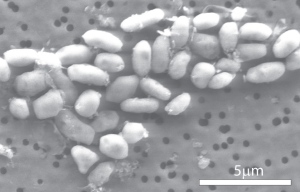arsenic-based life

GFAJ-1 bacteria can live where there are high concentrations of arsenic but doesn't, as early claims suggested, have arsenic in its DNA. Image credit: Science/AAAS.

Mono Lake, California, in which the GFAJ-1 microbes used in the NASA-funded study, referred to in this article, was found.
We normally think of arsenic, and its compounds, as being very poisonous, and it is indeed toxic to most living things on Earth. But because arsenic is chemically similar to phosphorus – one of the key elements in terrestrial life – it has been suggested that on some other worlds in the universe, there might be organisms which use arsenic as a key ingredient in their biochemistry. It's also been suggested that very early on, some life-forms on Earth may have incorporated arsenic into their DNA in place of phosphorus. Recently, the astrophysicist Paul Davies hypothesized that there might be an extant "shadow biosphere" on our planet, living alongside the life we know about, but with a different biochemical basis, such as silicon or arsenic.
Known occurrences of arsenic in terrestrial life
It's been known for some time that a few kinds of bacteria, algae, and fungi produce or make use of arsenic compounds as part of their metabolic activity. For example, there are marine algae which contain arsenosugars and compounds known as arsenobetaines. Some fungi and bacteria can produce volatile methylated arsenic compounds. And, in 2001, a team of scientists reported that a species of bacterium called Chrysiogenes arsenatis could reduce arsenates and thereby make oxygen available for cellular processes.1 But the idea that any organism could make use of arsenic as a central part of its life processes, by having it as a component of its DNA is highly controversial and not given credence by most biologists.
A sensational paper – and a toxic response
In 2010, a team of researchers, led by Felisa Wolfe-Simon, a microbiologist at the Lawrence Berkeley National Laboratory in California, published a remarkable paper in the journal Science in which they claimed to have discovered a bacterium that grew and metabolized using arsenic in place of phosphorus. The work was carried out using a grant from NASA, and, at the same time as the paper, NASA put out a document entitled "NASA-Funded Research Discovers Life Built With Toxic Chemical".
This claim was met with immediate skepticism, bordering on outright derision, in the biology community. Most experts in microbiology poured scorn on the claim that organisms on Earth could use arsenic as a substitute for phosphorus, and, indeed, this criticism has been borne out by subsequent investigations.3, 4 Although the bacterial species in question, GFAJ-1, is certainly highly tolerant of arsenic-rich environments, it turns out that, like all other terrestrial life, it uses phosphorus – not arsenic – in its DNA. What Wolfe-Simon and her team had discovered was not arsenic-based life but instead a microbial species of extremophiles that were able to tolerate high arsenic concentrations but still needed phosphorus to grow and divide.
Does that rule out the possibility of genuine arsenic-based life on other worlds? No, because we can't possibly know at this stage what viable alternative biochemistries might develop under totally different environmental conditions. The possibility that any present-day life on Earth in which arsenic has completely taken over the role of phosphorus, however, seems remote.
References
1. Niggemyer, A., Spring, S., Stackebrandt, E., Rosenzweig, R. F. "Isolation
and characterization of a novel As(V)-reducing bacterium: implications
for arsenic mobilization and the genus Desulfitobacterium". Appl Environ Microbiol, 67, (12): 5568–80, December 2001.
2. Wolfe-Simon, Felisa; Blum, Jodi Switzer; Kulp, Thomas R.; Gordon,
Shelley E.; Hoeft, S. E.; Pett-Ridge, Jennifer; Stolz, John F.; Webb,
Samuel M. et al. "A bacterium that can grow by using arsenic instead
of phosphorus". Science, 332, (6034): 1163–6, 2 December 2010.
3. Reaves, M. L., Sinha, S., Rabinowitz, J. D., Kruglyak, L., and Redfield,
R. J. "Absence
of Detectable Arsenate in DNA from Arsenate-Grown GFAJ-1 Cells." Science (2012).
4. Erb, T. J., Kiefer, P., Hattendorf, B., Günther, D., and Vorholt,
J. A. "GFAJ-1
Is an Arsenate-Resistant, Phosphate-Dependent Organism." Science (2012).


